2012 VOLKSWAGEN GOLF MK6 steering
[x] Cancel search: steeringPage 126 of 516
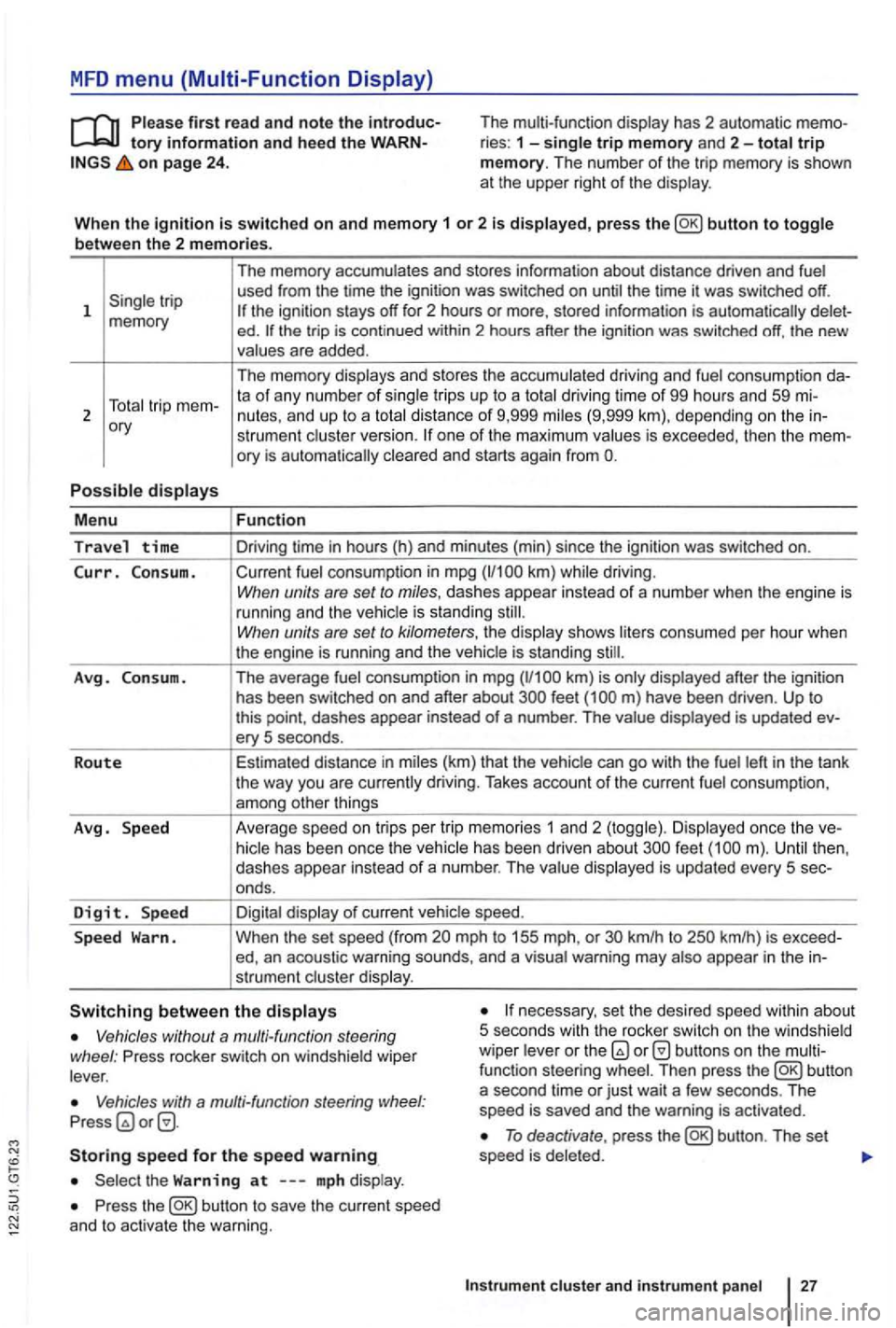
MFD menu (Multi-Function Display)
tory information and hee d the on page 24 . The multi-function
display has 2 automatic ries : 1 -single trip memory and 2-total trip memory. The number of the trip memory is shown
at the upper right of the display .
Wh en th e
ignition is switched on and memory 1 or 2 is displayed, press button to toggle
b etwee n the 2 m em ories.
1
ory
P o
ssible displays
M enu
Travel time
Curr. C on sum.
A vg . Consu m .
R o
ute
Avg . Speed
D
igit. Sp ee d
S p ee d
Warn. The
memory accumulates and stores information about distance driven and fuel
used from the time the ignition was switched on until the time it was switched off.
ed . the trip is cont inued within 2 hours after the ignition was switched off, the new
values are added .
The memory displays and stores the accumulated driving and fuel consumption
strumen t cluste r version. one of the maximum values is exceeded, then the
Fun ction
Driving time in hours (h) and minu tes (min) since the ignition was switched on.
Current fuel consumption in mpg
have been driven . Up to this point , dashes appear instead of a number . The value displayed is updated ery 5 seconds .
Estimated distance in miles (km) that the vehic le can
go with the fuel left in the tank
the way you are currently driving. Takes account of the current fuel consumpt ion ,
among other things
Ave rage speed on tri
ps per tr ip memor ies 1 an d 2 (toggle) . Di splayed once the feet
mph to 155 mph, or km/h to
necessary, set the desired speed within about
5 seco nds with th e rocker switch on the w indshield
wiper leve r or the Vehicles without a multi-function steering
wheel : Press rocker switch on windshie ld wiper
lever .
Vehicles with a multi-fun ction steering Press
Storing speed for the speed warning
Press the
To deactivate , press
Instrum ent cluste r and in str um en t panel
Page 135 of 516

Opening and closing
this section find info rmation about:
R em o
te control vehicle keys . . . . . . . . . . . . . . 37
Mec hanical key . . . . . . . . . . . . . . . . . . . . . . . . . 38
Volkswagen
Power locking and clos ing system 41
Starti ng and stopping the engine
Cons ume r inf ormat ion
Eme rgen cy closin g and opening
Always keep remote control vehicle key fobs with batteries, spare batterie s, as as
dead button mm batteries out of the reach of children.
Get medical attention immediately if you suspect that a battery has been swallowed .
use of vehicle key s can result in se-rious personal injury.
36 Before driving
Always take the key with you when you leave the vehicle . can be used to start the
engine and operate vehicle systems s uch as
the powe r windows, leading to se rious personal injury.
the vehicle is moving or to a stop. The steering wheel lock and you
Page 157 of 516
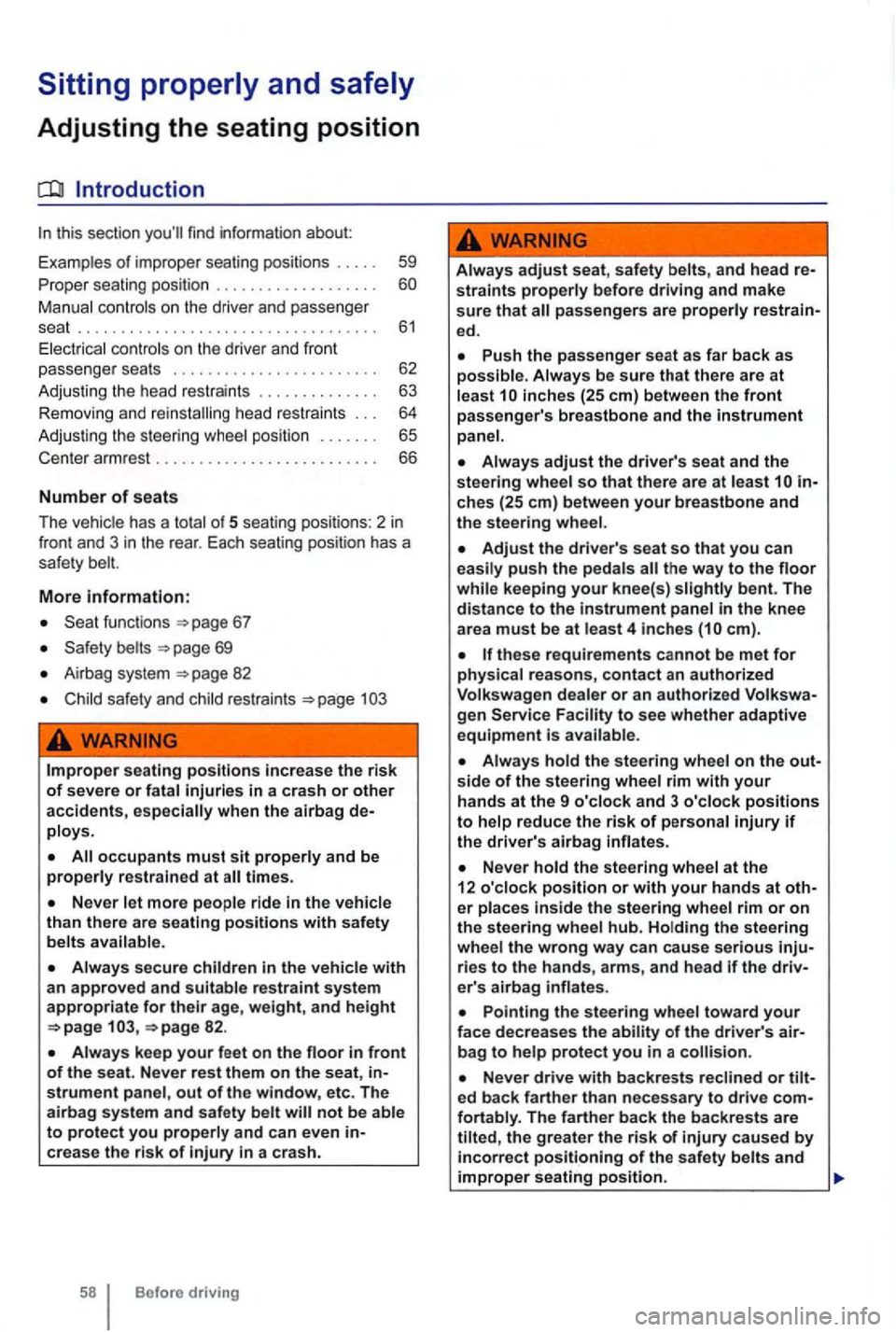
Adjusting the seating position
Introduction
this section find inf ormation about:
Examp les
of improper seat ing pos itions . . . 59
Pr ope r seating position . . . . . . . . . . . . .
Manual contr ols on the driver and passe nger
seat . . . . . . . . . . . . . . . . . . . . . . . . . . . . . . . . . . . 61 Ele ctrica l co ntr ols o n the driver and front
passenger seats . . . . . . . . . . . . . . . . . . . . . . . . 62
Adj ustin g
the head restra ints . . . . . . . . . . . . . 63
R emoving and re in stalling head restraints . . . 64
Adj usting the stee
ring whee l position . . . . . . . 65
Cen te r armrest . . . . . . . . . . . . . . . . . . . . . . . . . . 66
Number of seats
Th e vehicle
has a t otal of 5 seat ing posit ions: 2 in front and 3 in the rea r. Eac h seating pos ition has a
safety belt.
More information:
funct ions 67
page 69
Ai r ba g syste m 82
safety and child restraints
WARNING
Improper seat ing pos itions increase the risk of severe or fatal injuries in a crash or other accidents,
times .
Never
Always secure children in the vehicle with a n approved and suitable restraint system appropriate for their age, weight, and height 82 .
Always keep your feet on the in front of the seat. Never rest them on the seat,
Always adjust seat , safety belts, and head straints properly before driving and make sure that
inches (25 em) betw een the front pa ssenger' s breastbone and the in strument panel.
ches (25 em) between your breastbone and the steering wheel.
Adjust the driver's seat so that you can push the pedals while keeping your knee(s) slightly bent. The
di stance to the instrument panel in the knee
a rea must be at least 4 inche s
these requirements cannot be met for physical reason s, contact an authorized
Volk swagen dealer or an auth orized gen Facility to see whether adaptive equipment is avai la bl e.
Always hold the steering wheel on the side of the steering wheel rim with your hands at the 9 o'clock and 3 o'clock positions to help reduce the risk of personal injury if the driver's airbag inflates .
Never hold the steering whee l a t the
12 o'clock position or with your hands at e r places inside the steering whee l rim or on the steering wheel hub. Holding the steering wheel the wrong way can cause serious rie s to the hand s, arm s, and head if the
Pointing the steer ing whe el t oward your face dec reases the of the driver's bag to h elp protect you in a
Never drive with backrest s reclined or ed back farthe r than necessary to drive
Page 159 of 516
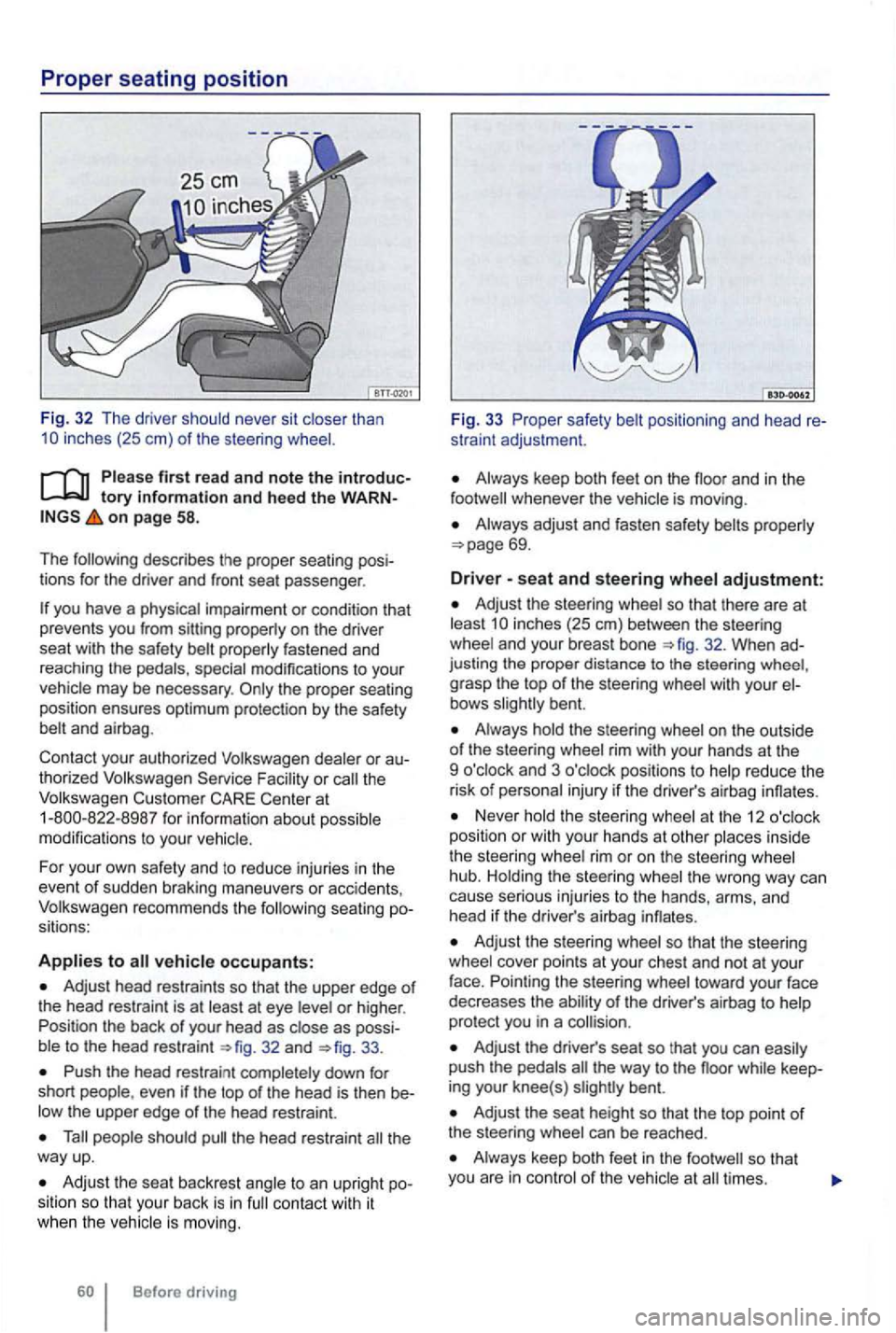
first rea d and note the introductory information and hee d the WARNon page 58.
The following describes the proper seating posi
tions for the driver and front seat passenger .
special modifications to your
vehicle may be necessary .
to
Adjust head restraints so that the upper edge of the head restraint is at least at eye
32 and 33.
Push the head restrai nt completely down for
short even if the top of the head is then be
people should the head restraint the way up.
Adjust the sea t backrest angle to an upright position so that your back is in contact with it when the veh icle is moving.
Before driving
Fig. 33 P roper safety
Always keep both feet on the whenever the vehicle is moving .
Always adjust and fasten safety belts properly
adjustment:
Adjust the steering whe el so that there are at least inches (25 em) between the steeri ng
wheel and your breast bone
grasp the top of the steering wheel with your bent.
Always hold the steering wheel on the outside of the steering wheel rim with your hands at the
9 o'clock and 3 o'clock positions to help reduce the
risk
of personal injury if the driver's airbag innates.
Never hold the steering wheel at the 12
and
head if th e driver's airbag innates.
Adjust the steering wheel so that the steering
wheel cover points at your chest and not at your
face. Pointing the steer ing wheel toward your face
dec reases the ability
of the driver's airbag to help
protec t you in a
Adjust the driver's seat so tha t you can easily push the pedals the way to the noor while keep
ing your knee(s) bent.
Adjust the seat height so that the top point o f
the steering wheel can be reached .
Always keep both feet in the times.
Page 164 of 516
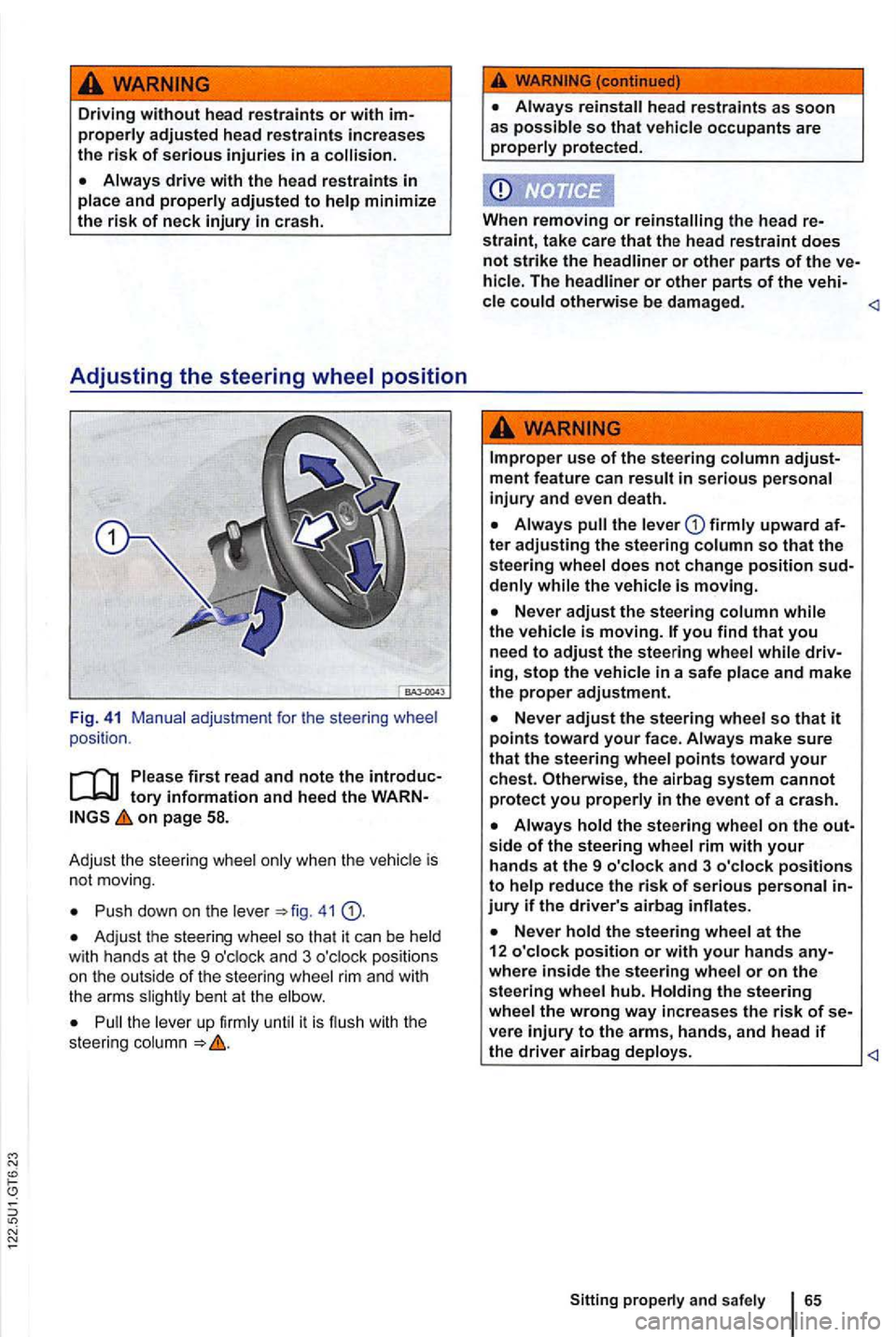
Driving without head restraints or with properly adjusted head restraints increases
the risk of serious injuries in a
tory information and heed the on page 58.
Adju st the steerin g whee l only w he n the veh icl e is
no t m ovi ng.
Push dow n o n the leve r 41
Adj ust th e steering whee l so th a t it ca n b e held w ith hands at the 9 o'cloc k and 3 o 'clock positio ns
o n the out side of the steering wheel rim and with
t he arms slightl y b ent at the elbow .
Pull the leve r up firml y until it is flu sh with th e
stee ring colum n
the lever
denly while the vehicle is moving.
Never adjust the steering wheel so that it points toward your face . Always make sure that the steering wheel points toward your chest. Otherwise, the airbag system cannot protect you properly in the event of a crash.
side of the steering wheel rim with your hands at the 9 o'clock and 3 o'clock positions to help reduce the risk of serious personal
where inside the steering wheel or on the steering wheel hub. Holding the steering wheel the wrong way increases the risk of vere injury to the arms, hands, and head if the driver airbag deploys.
Page 171 of 516
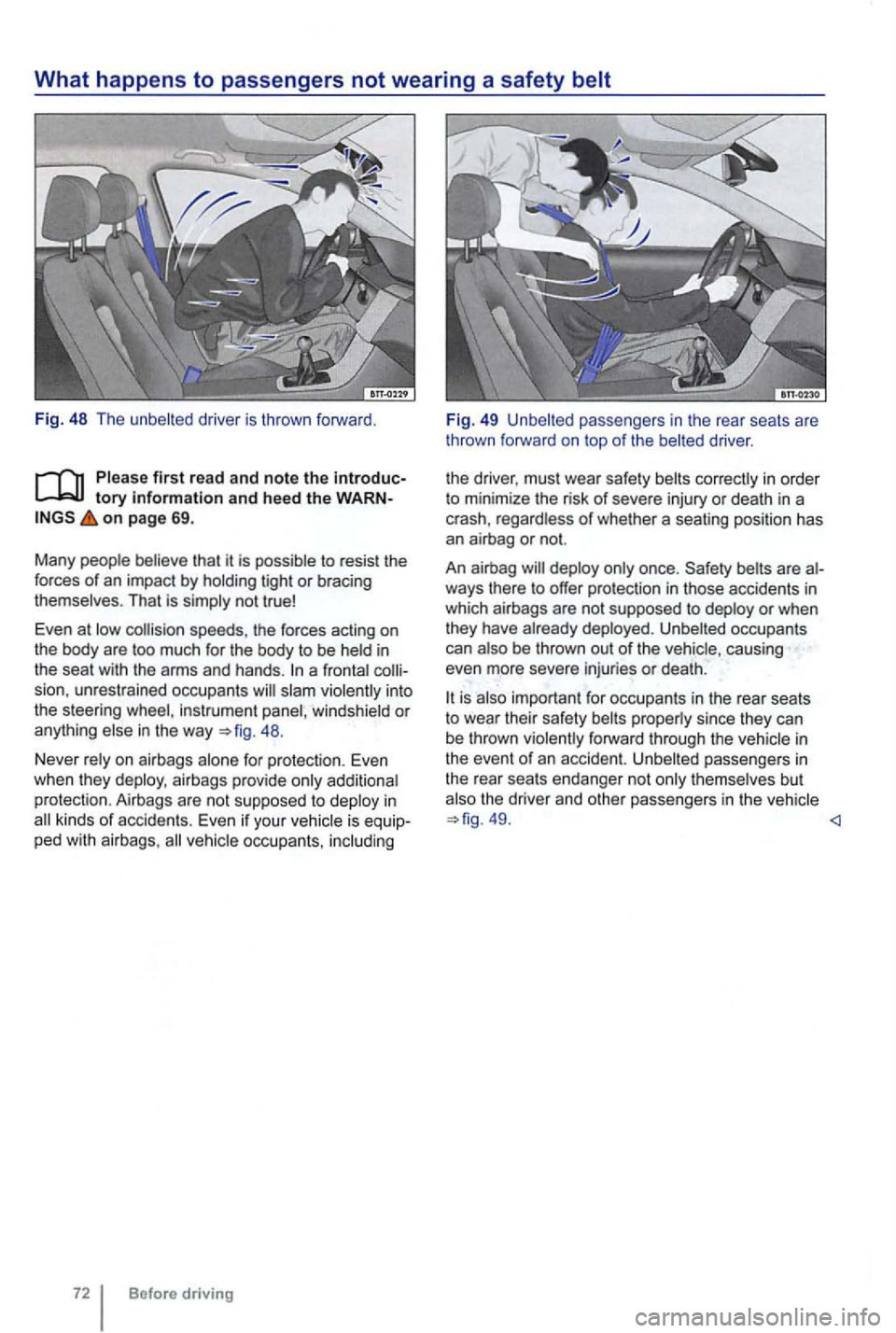
What happens to passengers not wearing a safety
driver is thrown forward.
tory and hee d the WARN on p age 69 .
Many
That is
in
the seat with the arms and hands . a into
the steering instrument in the way 48.
Never on airbags airbags provide protection. Airbags are not supposed to in kinds of accidents. Even if your
Befo re driving
Fig . 4 9 passengers in the rear seats are
th rown forward on top of the
in orde r
to min imize the risk of severe injury or death in a
crash , regardless
of whether a seating position has
an airbag or not.
An airbag
is since they can
be thrown forwa rd through the passengers in the rear seats endanger not but the driver and other passengers in the 49.
Page 181 of 516
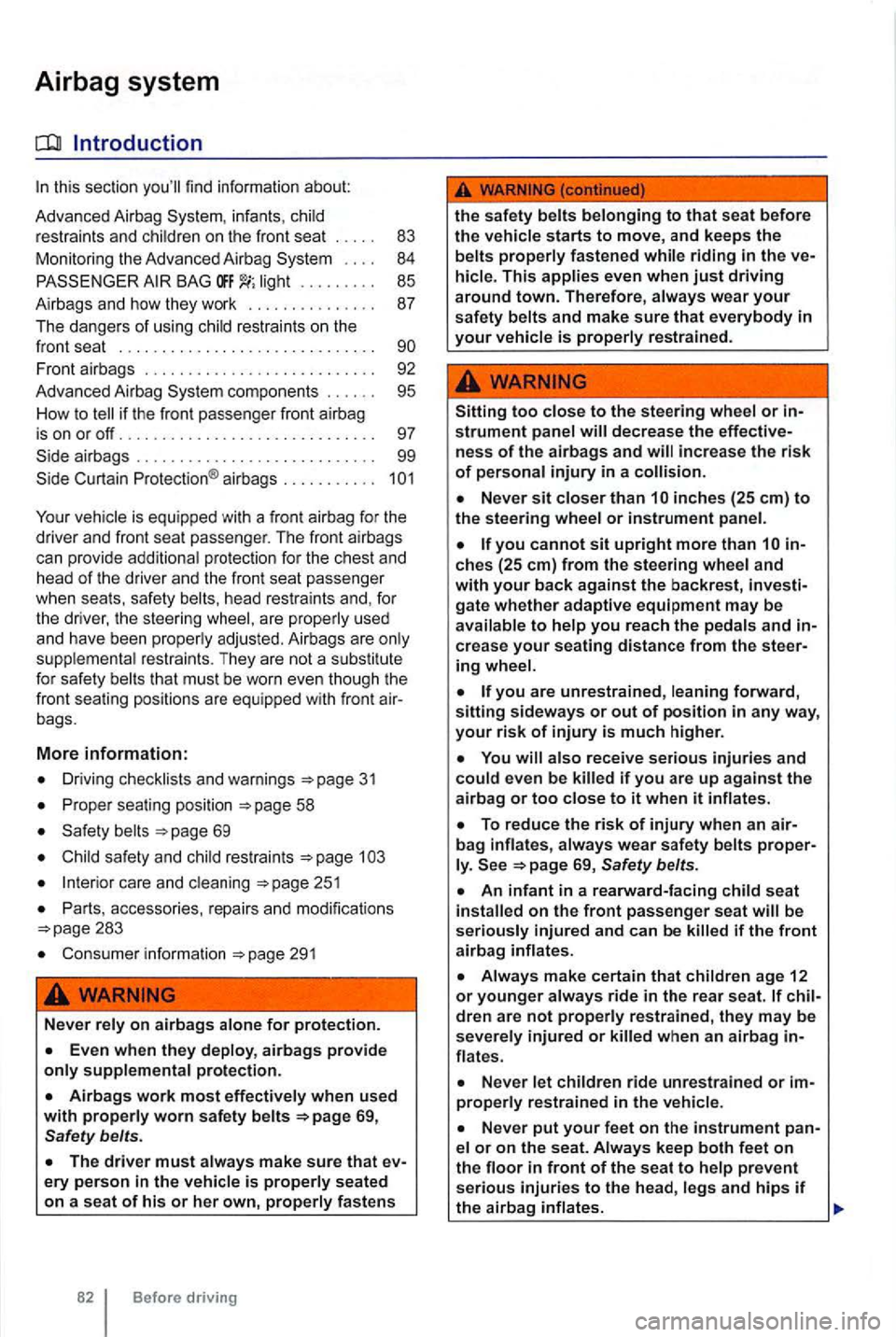
Airbag system
infants, rest ra ints and
. . . . 84
BAG . . . . . . . . . 85
Airbags and how they wo
rk . . . . . . . . . . . . . . . 87
The dangers of usi
ng restra ints o n the
front seat . . . . . . . . . . . . . . . . . . . . . . . . . .
F ront airbags . . . . . . . . . . . . . . . . . . . . . . . . . . . 92
Advanced Airbag
is equipped with a front airbag for the
drive r and front seat passe nger. The front airbags
can provide
head restraint s and , fo r
t h e driver , th e steer ing are used
and have been
restraints . They are not a substitute
for safety that must be worn even th ough the
f ro nt seat ing positions are equipped with front air
bags.
More information:
Driving 31
Prop er seating position
Parts , acc essor ies, repairs and modifications
Consumer inf ormation
airbags provide
worn safety 69, belts.
make sure that ev
ery p erson in the fa stens
82 Before driving
the safety
This even when just driving around town. Therefore ,
is
too
increase the risk of personal injury in a
or instrument
you cannot sit upright more than inches (25 em) from the steering and with your back against the backrest, inves tigate whether adaptive equipment may be you reach the and increa se your seating distance from the steering
you are unrestrained ,
re ceive serious injuries and if you are up agains t the
airbag or too to it when it
proper69, belts.
sea t on the front passe nger sea t be
seriously injured and ca n be
make certain that
dren are not properly res trained , they may be
seve rely injured or
in front of the seat to
Page 186 of 516
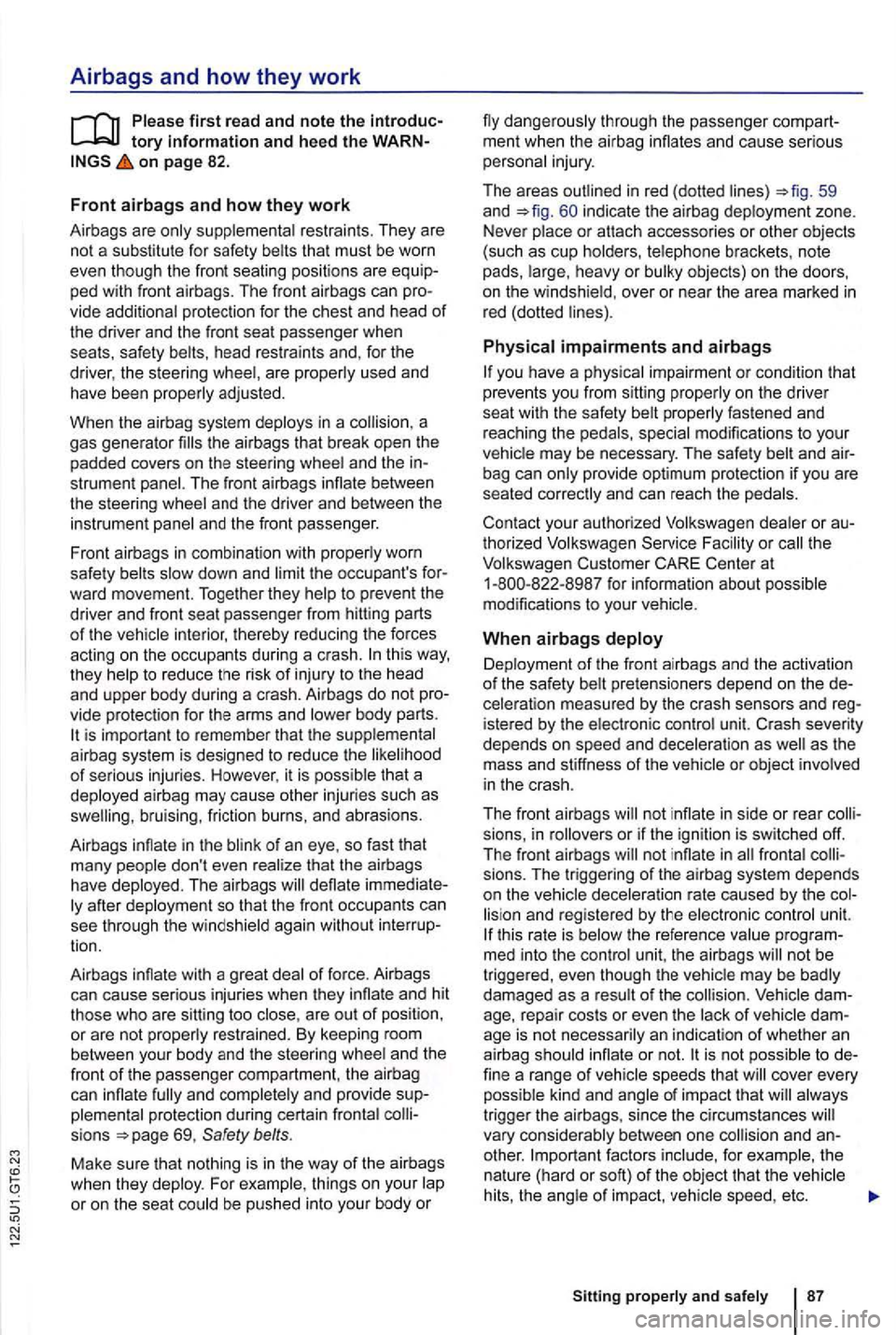
Airbags and how they work
on page 82.
Front airbags and how they work
Airbags are restraints . They are
not a substitu te for safety belts that must be worn
even though the front seating positions are
ped with front airbags . The front airb ags can
head restraints and, for the
driver, the steering are properly used and
have been
the airb ags that break open the
padded covers on the stee ring a nd the strume nt The front airb ags inflate between
the stee ring
and the front passe nger.
Front airbags in combination with properly worn
safe ty down and the occupant's for
ward movement. Together they to pre vent the
dri ver and front seat passenger from hitting parts
of the veh icle inter ior, thereby reduci ng the forces
acting on the occupa nts dur ing a crash. this way,
they to reduce the risk of inju ry to the head
and upper body during a crash. Airbags do not body parts. is i mport an t to remember that the
o f an eye, so fast that
many don't even real ize that the airb ags
have deployed. The airbags deflate after deployment so that the front occupants can
see through the w inds hield again without inte rrup
tion .
Airbags infl ate with a great
and the
front of th e passenger compartment, the airbag can inflate and provide protection during certain fronta l sions 69, belts.
Make sure th at nothing is in th e way of the airbags
when they deploy. For example , th ings on your be pushed into your body or
ment when the airb ag inflates and cause serious
personal in ju ry .
T he areas outlined in red (dotted
59 and indicate the airbag deploym ent zone .
N eve r
heavy or objects) on the doors, on the win dshie ld, over or near the area marked in red (do tted lin es).
you have a physical impairment or condition that
prevents you from sittin g on the driver
seat with the safety proper ly fas te ned and
r eac hing the pedals, special modifications to you r
ve hic
le may be necessary. The safety
o r thori zed Volkswagen or th e
Volkswage n Customer Center at for infor mation abo ut poss ible
modifications to your vehicle.
When airbags
Deployment of th e front airba gs and the activation
o f the safety cele rat ion measured by the crash sensors and reg
i ste red by the e lect ronic control unit. Cras h sever it y
depe nds on speed and decelerati on as as th e
m ass and sti ffn ess of the vehicle or object involved
i n th e crash .
T he front airbags
sions , in rollovers or if the ign itio n is sw itched off.
T he front airbags not inflate in fro nta l sions. The triggering of the airbag system depends
on the
and registered by the electronic contr ol unit. thi s ra te is th e refe ren ce program
med into the con tro l unit , the airbags not be
t r igge red, even though the veh ic le m ay be d amaged as a Veh icle age, repair costs o r eve n th e of damage is not necessarily an ind ica tion of wheth er an
a irbag inflate or not. is not possible to fine a ra ng e o f veh icle speeds that cover every
possible kind and of imp act tha t trigge r the airbags , since the circu mstances vary considerably between one collisio n and other . factors
of impact ,